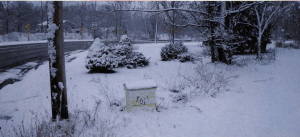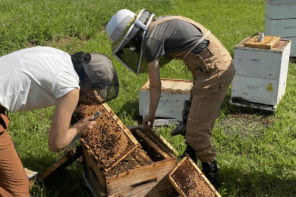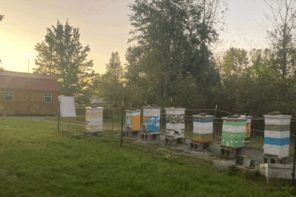By: Ann Harman
This article originally appeared in the Autumn 2016 issue of BEEKeeping Your First Three Years
In Antarctica, yes. But here in the temperate area of the United States, Winter is far from our minds. (If you are complaining that today is a scorcher, please think back to last Winter – those thoughts may cool you off a bit.) At this time you may have pulled your honey off and your thoughts are that the bees will be just fine until you check on them in early Autumn to get them ready for the coming Winter.
Actually that colony needs to be thought about during July. Remember that August is the bees’ New Year. Depending on your climate, in August your bees will be either producing Winter bees or getting ready to do that. Now just who is going to take care of the Winter Bee Project in August and September? The queen and those bees that are in your hive in July – the field bees bringing in food, the hive bees taking care of brood, and the brood itself – when those become adult bees. Bees are really so efficient. It’s the beekeeper who is always running to catch up.
Perhaps the major item of concern during July is Varroa. Your colony has been doing very well, meaning plenty of brood starting in early Spring to bring you that honey crop. However, the more larvae, the more mites. July is a great month to evaluate your Varroa control. No, you cannot eliminate every last one of them but you can control the Varroa population.
When was the last time you checked your screen bottom board? Probably in the middle or at the end of March when you went through your hives to see how everything was after the Winter. Some colonies keep the screen bottom board, and also solid bottoms, very clean. Other colonies don’t bother getting rid of trash. July is a hot month so any ventilation is beneficial. Take a look now and make a note (you are keeping records, aren’t you?) of untidy colonies.
Do you think your Varroa monitoring techniques – powdered sugar, sticky boards, alcohol wash, etc. – are giving you good information? Now is a good time to review those. Think back to the end of Winter in your area. How did your bees cope with Winter conditions? We cannot escape Mother Nature’s Wintertime tricks (or Summer ones, either) but plenty of food and plenty of healthy bees can get bees through the Winter in good condition.
Do you plan to use one of the Varroa medications? If so, review then to see which one would be the best for your bees and for your climate, as well as for your approach to beekeeping. The equipment suppliers have good descriptions in their catalogs or on their websites. Please pay attention to the label instructions for the temperature range. July is a hot month! It may be too hot in your area to use some of the medications.
Why so much fuss about Varroa? Well, it is considered the Number One problem of bees in the world. It is impossible to eliminate them from our hives. But it is possible to control them and the damage they can do. Take action before Summer. September may be too late. You need those strong, healthy Winter bees.
While we are thinking about pests, we need to consider the small hive beetle. In areas with loose sandy soil and reasonable or high humidity, the small hive beetle can be a terrible pest. In those areas with heavy, dense clay soil or low humidity the shb can just be a nuisance. However, any stress that a colony has to endure is simply not beneficial to its overall health and success. Since you are reviewing your Varroa control program, give a thought to your beetle control program.
You thought July would be a quiet month for your beekeeping. In some ways yes, but it is an excellent month for review.
As long as we are thinking about health problems, let’s consider Nosema ceranae. This is again a worldwide problem. Early research showed that ceranae was quite different from the familiar Nosema apis that gave problems during the Winter. This Nosema seems to be infesting the bees the year around. Unfortunately no consensus seems to exist on exactly what to do, what is best for our bees. Plenty of food and plenty of healthy bees seem to be the best defense. However, keep up with information from current research.
Beekeepers tend to make thorough inspections of their colonies in the Spring. If all is well at that time then all must be well in July. Maybe. When you made those Spring inspections you probably decided if a queen or two needed replacing after the Winter. Now, some months from Spring, have you thought about all the queens? Do you have records about the ages of your queens? If so, it’s time to review those to see if an Autumn requeening will be needed. Go ahead and see what your queens are doing. Note the colonies that need a new one and decide on the appropriate time to requeen. Those new queens will be needed to lay the eggs for the Winter bees.
Did you have similar honey harvests from all your colonies or was there one that just didn’t produce? Now is the time to decide the fate of that wimpy colony. It does not show any signs of disease or parasites. Its problem is probably a wimpy queen. July is an excellent time to decide on her fate. A new queen could definitely be in order. However, would those bees be a good addition to another colony a bit later? Remember: one wimpy colony plus another wimpy colony equals a wimpy colony. Nothing really gained. Go ahead and blame the queens but don’t try to coddle along a wimpy colony. If you do, your reward will be a dead colony before next Winter ends. Have you been keeping track of your weather, at least during the past month or so? Too much rain? Too little rain? Some parts of the United States may have been experiencing drought, even severe drought conditions. You probably paid more attention to the effects of drought on your tomato plants. Bee forage will suffer from drought – small and sparse blossoms, very little nectar. Go ahead and water your tomatoes then mix up some sugar syrup for feeding your bees.
It does not matter what month your calendar says.
What about too much rain, especially day after day? Bees will stay home. Incoming food, pollen and nectar, could be in short supply. Plants tend to grow more foliage but not necessarily more blossoms. Nectar may be more dilute. The higher level of humidity will make it more difficult for the bees to evaporate water from the nectar. There is no point in adding more stress to your colonies by plowing too frequently through the hive to discover what is going on. Take a few minutes and watch bees at the entrance. Do you see any arriving bees with pollen? Those appearing to arrive with ‘nothing’ could be scout bees, nectar carriers, water carriers – or actually really nothing. Link the weather with action at the entrance.
Nobody with pollen? Brood is still being reared. Check entering bees at different times of day since blossoms release pollen at different times. Sunny and incredibly hot? Bees will be bringing in water (the ‘nothing’ bees). Do you know your water sources? In severe drought conditions tiny streams may dry up completely. Are you familiar with the nectar plants in your area? If not, find out to make certain some of those ‘nothing’ bees are bringing in nectar. Bees fanning at the entrance? Good! Nectar being evaporated and/or the cooling-hive bees are at work. Watching bees at the entrance is lots of fun and quite informative, too.
Now that the July assessment of colony conditions has been done you can make your plans for the months to come. Remember- those plans must be somewhat flexible – weather from now until next Spring can alter them.
When August, or early September, arrives you may be requeening. Those beekeepers who plan to overwinter nucs will be caring for those. In many temperate areas August can be a dearth month for blossoms. However the eggs for Winter bees will be laid. These are the bees responsible for successful wintering of a colony. The larvae will need good nutrition to be vigorous healthy bees.
In general beekeepers just have the months of August and September to help the bees create a good Winter colony. As cooler weather and diminishing light appears in October many perfectly healthy queens are guided into diminished egg laying, beginning their rest period.
You have turned the calendar page to October. The colorful Autumn leaves will give you a pleasant backdrop to your finishing touches of preparing your hives for Winter. When Halloween arrives you should be finished with hive work. The queen is resting. Plenty of pounds of honey are available for Winter. Promise your bees that you will look into the hive from time to time to be certain all is well. Now you can go and enjoy goblins and ghosts and skeletons!
The calendar says November now. If you have done a good job of feeding you can finish cleaning up the beeyard, your smoker and hive tools. Be certain you launder any bee jackets or coveralls that you have been wearing. Dried venom, if inhaled, can cause venom allergy.
Did you think you could ignore the weather? No, indeed. A good chilly November keeps the bees in a cluster and being conservative of food. A series of warm days for flight means the bees are eating more. Will their food stores last the Winter? Make a note in your records because when January arrives you will have totally forgotten November.
The days are now short and cold, telling us it’s December and Winter. ls there anything special to note about the weather this month? Find a day, just one day, in December when you could remove the covers and take a quick look inside. The grumbling hum of annoyed bees does tell you that they are in residence. Since it is early in Winter you probably will not see the bees. That means they are far below their stores and doing well. Gently replace the covers and wish them a Merry Christmas.









